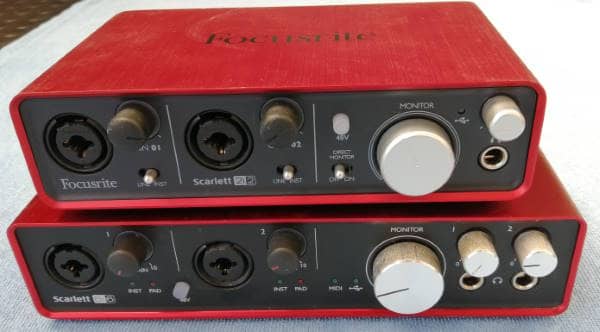
To get your audio source into your computer you need an audio interface. Whether you’re recording audio via a microphone or you’re directly connecting an instrument such as a guitar, bass or keyboard, an audio interface is essential. We are fortunate these days in that there are lots of high-quality interfaces on the market at very reasonable prices.
I have been using the Focusrite Scarlett (affiliate link to Amazon) series of interfaces for a few years now, and I can highly recommend them. The sound quality, and in particular the pre-amps, is on a par with pro interfaces costing much more. Add in the rugged build quality and ease of use, and you can see why I own two of these things!
In particular I recommend (all Amazon affiliate links)…
- Focusrite Scarlett Solo – as simple as you can get, a great first starter interface. Has 2 inputs – one an XLR for a microphone, and one ¼ inch jack for an instrument.
- Focusrite Scarlett 2i2 – the next model up in the range. Has 2 inputs again, but this time they are both combination XLR/¼ inch jack inputs, so you could plug in 2 microphones or 2 instruments at the same time.
- Focusrite Scarlett 4i4 – again has the 2 combination inputs, but has the addition of a MIDI interface. Very useful if you are a keyboard player and you want to record MIDI.
It’s worth pointing out that the sound quality is exactly the same of the Solo as it is on the 4i4. As you go up the range you are paying for more connectivity, not better sound quality. So the Solo sounds just as good as the 4i4, and even models higher up in the range (such as the 18i8).
I made my 2 EPs using my trusty Focusrite. Check this page for links if you’d like to have a listen.
Why I picked Focusrite Scarlett
The Focusrite Scarlett series is in its 3rd generation now, and they just keep getting better with each version. Some reasons to choose a model from this range are …
- The mic pre-amps are highly regarded throughout the audio industry and will help you get excellent recordings.
- Build quality – these things are built like tanks! Great if you record in multiple locations and your interface is likely to get knocked about a bit
- Ease of use – they are largely intuitive, needing minimal manual reading to get going
- The red/green indicators round the gain knobs to indicate clipping/ok level just look cool 😉
Do you need MIDI?
The Solo and 2i2 models are great if you don’t use MIDI. However, if you do own a MIDI keyboard and would like to record it, the 4i4 does have MIDI IN an OUT connections on the rear.
You can always add a separate MIDI interface later, if you don’t require it now but think you may need it in the future.
How many inputs?
How many inputs you need is entirely dependent on how many audio sources you are going to record at the same time. If, like most of us, it’s just you recording in your home studio then two inputs will be plenty. You only need more if you are going to be mic’ing up a full drumset, in which case I would advise you need a minimum of eight.
Using with high-output guitar pickups
You may have heard that the Focusrite Scarlett range used to have a problem with high output electric guitar pickups, such as active humbuckers (EMGs, etc). The high output from these pickups used to be too hot for the inputs on the interfaces, and you would get unpleasant distortion even with the gain on its lowest setting.
This was only a problem on the first generation of the interfaces. We are now onto the third generation so this is no longer something you need to worry about.
USB powered vs external mains power supply
The Solo, 2i2 and 4i4 are all powered via the USB connection to the computer. This means that there is no need for an external power supply plugged into the mains. Obviously this is very useful if you record on location with your laptop; no need to worry about if there is a mains wall socket available.
Bundled software
At the time of writing, the Scarlett interfaces come bundled with several audio software programs, including….
- Pro Tools first
- Ableton Live Lite
- Several effects plugins
Personally, the only software out of these I have used are the effects plugins. But I know lots of people who swear by both Pro-Tools and Ableton Live, so this might be something that persuades you to go for the Focusrites over other interfaces on the market.
Software I have used with the Focusrite Scarlett
My DAW of choice is Reaper, and have spent a lot of time recording into Reaper via the Focusrite Scarlett. They work extremely well together, and it’s easy to setup Reaper to use with the Scarlett.
I also use guitar amp sims to both record into Reaper (as a plugin) and standalone just to practice guitar. My favorite amp sim is BIAS FX, and again it works extremely well with the Focusrite and is trivial to set-up.
Audio interface or sound card?
Functionally, there is no difference between an audio interface and a specialist music sound card. However, I would always recommend an audio interface these days just for the convenience factor.
Installing an audio interface is simply a matter of taking it out of the box, and connecting it to a free USB port on your computer. Contrast this with the pain of having to open up your computer, install the sound card internally, then configure it in your BIOS and/or operating system. Plus you can use an audio interface with a laptop. Audio interfaces are the clear winner for me.

